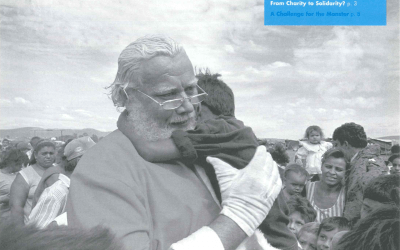Afterword: Philanthropy for Global Equity
Among the sayings attributed to Yogi Berra is: “Predictions are very difficult, especially if it’s about the future!” No one, therefore, can project with certainty the next phase of world philanthropic developments. My own hope is that philanthropy–as an organized sector, a field of study, and a social enterprise–will rise to the challenge of tackling global “unfairness” or inequities. Several reasons can be advanced as to why global equity should become a central thematic of the next philanthropic wave.
Every epoch of history can be characterized by some distinguishing attributes. For our times, the lack of “global fairness,” characterized by severe inequality, is perhaps the most striking. Inequality describes objective differences, but the term “inequity” introduces a normative or moral lens to inequality. Some inequalities may be unavoidable, for example birth defects. Other inequalities, however, may be considered grossly unfair, for example a child’s life chances damaged by lack of schooling or an AIDS patient denied access to life-saving drugs. The term equity captures social perceptions about the “fairness” of observed inequalities.
Social inequity erodes trust, breeds violence, disturbs the functioning of social institutions, and wastes the talent and capabilities of human resources. In today’s world, huge inequalities exist according to class, gender, ethnicity, and other social characteristics. These disparities in wealth and income, health and education, and social and political participation exist in all of the major world regions, including the wealthiest. These divides can be found both among and within nation states. Massive gaps differentiate the world’s richest and poorest societies, and all countries to varying degrees have disparities within their societies. Inequality and inequity within nations are particularly severe in many Latin American countries. The causes, while controversial, are both historical and contemporary. The cleavages are deeply imbedded in colonialism, but the divides have also been exacerbated by globalization in the 1990s.
UN Secretary-General Kofi Annan recently reminded us that: “We live in a world in which immense wealth and extreme poverty live side by side.” Globalization of private markets, technological advances, and new ground rules are producing unprecedented wealth concentrations, manifested by growing income inequalities among and within countries. Indeed, heightened public concerns and growing political opposition over increasing inequality are among the principal threats to globalization itself. Socially intolerable and morally unacceptable inequality is perhaps the foremost challenge of our times.
Challenging Social Inequities
One response to this challenge was the September 2000 endorsement of the millennium goals of the world community at the United Nations: Halving world poverty and achieving associated health and educational targets by 2015 are daunting challenges that will require resources and strategies, institutions and programs, and public understanding and political leadership. None of these necessary conditions, unfortunately, is evident. Public financing for world development has been steadily dwindling for a decade. Reform of the institutional architecture for development has faltered, and few fresh policies or programs are emerging. No consensus exists on effective strategies for alleviating poverty. Most important, public support appears fatigued over past disappointments and skeptical over unattainable promises. Genuine political will, especially among the powerful and wealthy, has not been demonstrably strong. Realistic appraisal of prospects for achieving the millennium goals, therefore, can hardly be optimistic.
Yet, global equity is a socially-valued motive force that can be mobilized to help advance equitable world development. Established modes of international development need revitalization. Traditional development approaches underappreciate inequity within Southern societies; it relies on North-South official aid transfers implemented through donor-funded projects to correct for inequities among nations. The theory that poorer countries ultimately would attain economic growth mirroring the experience of richer countries miscomprehends the unique historical contexts and the international linkages that characterize today’s world. No one today really believes that Sierra Leone will someday look like Switzerland! Rather, we appear to be heading towards a more uncertain, pluralistic, and unequal world.
A global equity approach would call for value-based mobilization of all resources–public, private, domestic and international–to redirect national and global institutions towards more socially-equitable outcomes in both the South and North. While broad in scope, this mission can be translated into many practical activities in education, health, and economic development. Just as globalization brings threats, it also offers opportunities. Access to new markets could help the poor generate their own wealth. Harnessing new technologies could help bridge health and educational gaps. Connectivity could empower groups to perform more effectively. Linking fresh approaches with new organizational arrangements is essential because existing institutions were crafted to solve problems of an earlier era. Governments continue to play a central role, but the public sector is being downsized. Inter-governmental organizations like the UN and the World Bank operate under similar constraints. The private sector, especially business and the media, has grown correspondingly more powerful. Civil society organizations are proliferating, reflecting the search for new solutions in democratic societies. To solve today’s problem, no single actor has all of the necessary resources, incentives, or capabilities.
Globalizing Philanthropy
Equity and philanthropy come together easily for several reasons. They are two sides of the same coin. The origin of philanthropy is wealth; charitable giving redistributes wealth, and strategic philanthropy addresses the root causes of unacceptable inequality. Both equity and philanthropy are important aspects of a socially-successful global economy. The former is a socially-valued goal in market economies, and the latter is a socially-desired outcome of excessive wealth accumulation. Linking equity and philanthropy can generate synergism because equity concepts can be strengthened by practical philanthropic action, and philanthropic practice can be informed by social purpose.
That social purpose urgently needs “out-of-the-box” thinking, strategies, and leadership. Innovation will require flexible social investment funds, just as technology start-ups need venture commercial capital. Despite the recent drop of the Nasdaq, the global economy is producing enormous wealth. The July 2001 issue of Forbes reported that the U.S. has more than 400 billionaires, 350,000 deci-millionaires, and 7 million households with investable assets exceeding $1 million. Changes in inheritance tax laws notwithstanding, an estimated $12-15 trillion will be transferred across American generations in the next two decades. And wealth accumulation has also been impressive in other world regions, especially in Europe and in many emerging economies.
The dynamism of recent philanthropy raises the prospect of a “second golden era.” Wealth accumulation of the 1990s has been so large that philanthropy is likely to continue its growth. New actors are entering, and philanthropy is emerging rapidly in Europe and in many middle- and low-income countries. New resources have sparked fresh attitudes, new approaches, and different actor groups–spawning new models and forms of philanthropy–such as venture, e-philanthropy, and diaspora. Taken together, global philanthropy has enormous unrealized potential for promoting fresh thinking, new approaches, and sustainable solutions to some of the world’s toughest problems, beyond the inflexibility of government or the narrower interests of business.
Of particular interest is that portion of philanthropy or private social investing that is strategically deployed to address world poverty and social injustice. The perspective “global” connotes a worldwide perspective; the term “strategy” implies investments for sustained solutions; and the challenges are the pre-eminent world problems of poverty, inequity, illiteracy, ill health, economic impoverishment, environmental degradation, and violation of human dignity. Defined as such, globalizing philanthropy constitutes a very small share of American and European charitable giving, but a very large part of the world”s social agenda.
The Future Agenda
Is there the philanthropic will to tackle social inequities, and if so, can private social investing make a difference? The answer is a qualified yes, if social passions can be ignited and social responsibility recognized. The challenge of performance confronts the entire sector. Is an appropriate framework that of transparency and accountability, and thus the legitimacy of philanthropy in democratic societies? If so, philanthropic programs that aim to advance equity must adhere to high standards of accountability for ultimate impact. Should philanthropy be considered a “social market”? If so, philanthropy as a field suffers from severe market failures. Extremely limited philanthropic supply faces virtually unlimited grantee demand, without price or other signals for mediation. The current philanthropic marketplace can be characterized as mostly informational, relational, and reputational. Constraining all actors are the lack of information, fragmentation, competition, duplication, and limited institutional mechanisms. Feeble are the voices, views and experiences of clients, communities, and recipient organizations that would bring greater openness and equity in their access to precious philanthropic resources. A weak knowledge base translates into an inability to reach consensus on lessons learned, to disseminate best practices, and to assess philanthropic performance. Although these limitations characterize the field overall, the obstacles are particularly crippling to global philanthropy because of the natural empathy for giving closer to home, the complexity of transnational transfers, and the handicap that distance imposes on confidence and trust.
Although the field of philanthropy shares common challenges, a global approach is distinctive. There is first of all the very rich tradition of indigenous philanthropy in nearly all cultures, and Latin America is no exception to this diversity. Problem-solving in resource-poor settings calls for distinctive low-cost solutions. Private giving from rich countries for work in poor countries must overcome diverse tax and regulatory hurdles. Differing from its local counterpart, global philanthropy engages a unique cluster of actors–some foundations, non-governmental organizations, governments in poorer countries, bilateral donor and multilateral agencies like the UN and World Bank, specialized academic units, and multinational business. Global philanthropy, moreover, encompasses not only the international giving by American and European philanthropies, but is inclusive of a growing number of new foundations in middle-income and even in some of the world’s poorest countries. While conceptually visualizing people in the world without national borders, global philanthropy faces a distinctive set of questions. How to learn, monitor, and assess the impact of social investments? How to select investments for specific countries or problems? How to expand interests in global justice among predominately domestic funders in rich countries?
Geographic border are increasingly porous in our globalizing world, and political boundaries do not define our moral compass, our social responsibility, or even our enlightened self-interest. Although no society–rich or poor–has eradicated poverty, some of the greatest inequality in the world can be found within developing countries (although more than 85 percent of world income inequality is between, not within, countries). In a shrinking world, the gaps between the privileged and impoverished are vast, and some say growing. Time and opportunity make philanthropy for global equity ripe for the next phase of world philanthropic developments. In developing countries, especially in Latin America, addressing internal disparities is essential for maintaining democratic institutions and economic development. The task is essentially local and national. But in our globalizing world, global responsibility, reinforcement, and solidarity are also vital.
Spring 2002, Volume I, Number 3
Lincoln Chen is a faculty member at Harvard’s Kennedy School of Government. Previously, he had been Takemi professor of international health and director of the university-wide Harvard Center for Population and Development Studies. For two decades, he worked for several of America’s largest foundations, including Rockefeller Foundation (executive vice-president), Ford Foundation (representative to India), and MacArthur Foundation (chair, international advisory committee).
Related Articles
Obras de Infraestructura Básica de Fácil Ejecución a través de la Autogestión
En el Ecuador rural y en las zonas citadinas marginales, la carencia de servicios básicos se ha convertido en un mal endémico no resuelto hasta …
Responsabilidad Social Empresarial: Algunos Hechos Que Cuentan
La Responsabilidad Social Corporativa (RSC) es una temática más bien nueva en Chile. Aún cuando se encuentran acciones filantrópicas desde tiempos de la colonia, la relación de la …
Algunos Casos en Chile
Un caso fue José Tomás Urmeneta, un empresario del siglo XIX quien, en un momento de auge del sector agroexportador chileno, en su testamento dejó asignados recursos para …




